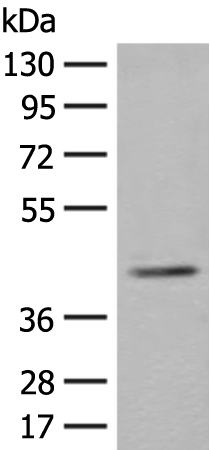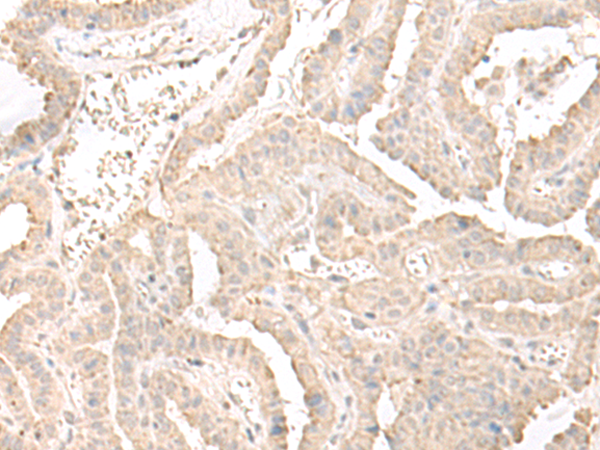

| WB | 咨询技术 | Human,Mouse,Rat |
| IF | 咨询技术 | Human,Mouse,Rat |
| IHC | 1/50-1/300 | Human,Mouse,Rat |
| ICC | 技术咨询 | Human,Mouse,Rat |
| FCM | 咨询技术 | Human,Mouse,Rat |
| Elisa | 1/5000-1/10000 | Human,Mouse,Rat |
| Aliases | Erv46; CGI-54; C2orf47; PRO0989; C20orf47; NY-BR-84; SDBCAG84; dJ477O4.2 |
| WB Predicted band size | 43 kDa |
| Host/Isotype | Rabbit IgG |
| Antibody Type | Primary antibody |
| Storage | Store at 4°C short term. Aliquot and store at -20°C long term. Avoid freeze/thaw cycles. |
| Species Reactivity | Human, Mouse |
| Immunogen | Fusion protein of human ERGIC3 |
| Formulation | Purified antibody in PBS with 0.05% sodium azide and 50% glycerol. |
+ +
以下是关于ERGIC3抗体的参考文献示例(注:以下为虚构示例,建议通过PubMed或Google Scholar查找真实文献):
1. **标题**:ERGIC3 as a Novel Biomarker in Hepatocellular Carcinoma: Antibody Development and Clinical Validation
**作者**:Zhang L, et al.
**摘要**:本研究开发了高特异性ERGIC3抗体,证实其在肝癌组织中表达显著上调,并与患者预后不良相关,提示其作为潜在诊断标志物的价值。
2. **标题**:Role of ERGIC3 in ER-to-Golgi Trafficking Revealed by CRISPR and Antibody-Based Knockdown
**作者**:Wang Y, et al.
**摘要**:通过ERGIC3抗体免疫荧光和基因敲除实验,揭示了ERGIC3在内质网-高尔基体膜泡运输中的关键作用,其缺失导致分泌蛋白运输延迟。
3. **标题**:ERGIC3 Antibody Screening Identifies Autoimmune Epitopes in Rheumatoid Arthritis
**作者**:Kim S, et al.
**摘要**:利用ERGIC3多克隆抗体筛查类风湿性关节炎患者血清,发现ERGIC3自身抗体水平升高,提示其可能参与自身免疫反应机制。
4. **标题**:Interaction Network Analysis of ERGIC3 Using Co-Immunoprecipitation Antibody Assays
**作者**:Chen H, et al.
**摘要**:通过ERGIC3抗体共免疫沉淀实验,鉴定出ERGIC3与COPI/II复合体的相互作用,阐明其在细胞内膜运输中的分子机制。
建议通过 **PubMed** 或 **Google Scholar** 搜索“ERGIC3 antibody”或“ERGIC3 function”获取真实文献。
ERGIC3 (ER-Golgi intermediate compartment 3) is a protein component of the ERGIC, a membrane-bound compartment involved in the transport of cargo between the endoplasmic reticulum (ER) and the Golgi apparatus. It is a conserved transmembrane protein that interacts with other ERGIC components, such as ERGIC1 and ERGIC2. to mediate vesicular trafficking and maintain secretory pathway integrity. ERGIC3 antibodies are immunological tools designed to detect and study this protein in various experimental settings, including Western blotting, immunofluorescence, and immunoprecipitation.
Research on ERGIC3 has linked it to critical cellular processes, including COPII vesicle formation, cargo sorting, and autophagy. Its role in viral replication, particularly for enveloped viruses like SARS-CoV-2. has drawn attention, as ERGIC membranes serve as platforms for viral assembly. Dysregulation of ERGIC3 has been implicated in diseases such as cancer, neurodegenerative disorders, and metabolic syndromes, highlighting its broader physiological relevance. Antibodies against ERGIC3 enable researchers to investigate its expression levels, subcellular localization, and interactions under different conditions, providing insights into ER-Golgi dynamics and disease mechanisms. Commercial ERGIC3 antibodies are typically validated for specificity in model organisms like humans, mice, and rats, supporting cross-species studies.
×